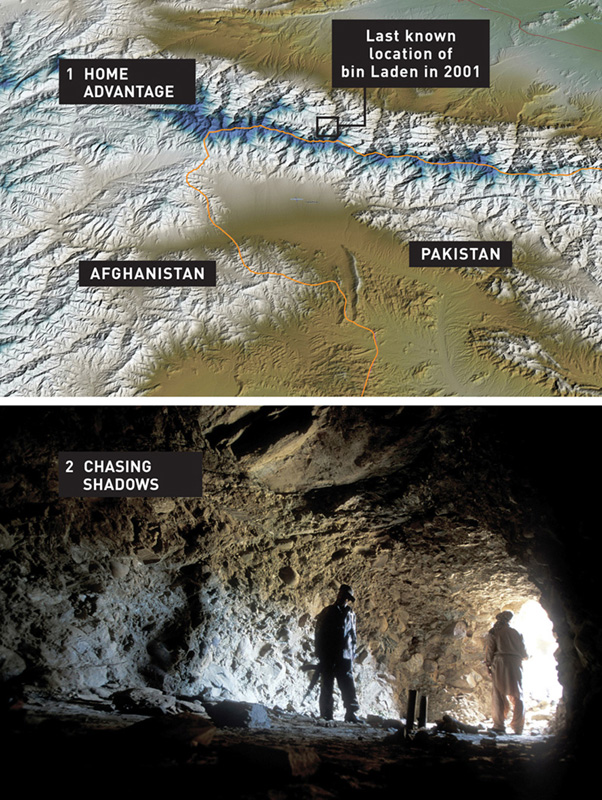
LOCATION Nangarhar Province, Afghanistan
NEAREST POPULATION HUB Jalalabad
SECRECY OVERVIEW Access restricted: fabled cave network used by Osama bin Laden.
The caves of Tora Bora shot to the attention of the world in 2001, when they became the focus of US attacks against Afghanistan’s ruling Taliban and Osama bin Laden’s Al-Qaeda. After a ferocious battle, bin Laden somehow evaded the grasp of US forces and dodged capture for a further ten years. Tora Bora itself became the subject of rumor, myth and confusion, often serving to disguise the truth.
The Tora Bora caves were formed naturally by water running through the limestone of the White Mountains in eastern Afghanistan. The range rises to over 4,000 meters (13,100 ft), its terrain often steep and its peaks snow-capped. In the 1980s the caves, which lie within easy reach of the Pakistani border, served as a labyrinthine base for the mujahideen insurgents fighting against the Soviet occupation of the country, which had begun in 1979. The rebels extended the complex using money supplied by the CIA, and it was during this time that bin Laden first became familiar with them. It was said that he later used some of his own vast personal wealth (as well as his expertise as a civil engineering graduate) to have them enlarged and upgraded beyond recognition.
After the September 11 terrorist attacks on America made a massive retaliation inevitable, bin Laden withdrew into this secret complex, apparently with a sizable army of Taliban and Al-Qaeda fighters. In early December 2001, two months after the beginning of the Allied air campaign, a force of Afghan Northern Alliance fighters backed by small numbers of US troops began a ground assault on the caves. By that time, Tora Bora had already been subject to several weeks of bombardment and aerial attack. The fighting was hard, and dragged on for several more weeks before bin Laden’s men were dislodged. He is believed to have left the scene sometime around December 16. In 2009, a US Senate Foreign Relations Committee concluded that the Battle of Tora Bora represented a prime opportunity to capture bin Laden, and that if the assault on the caves had been better coordinated, he might not have remained free until 2011.

SHOCK AND AWE A phalanx of Afghan anti-Taliban fighters look on as plumes of smoke rise during US bombing raids on Tora Bora in December 2001. The US assault made use of devastating BLU-82 “daisy cutter” bombs, but despite the intensity of the attacks, Osama bin Laden was able to escape capture.
At the height of the battle, the Western media made some extraordinary claims about Tora Bora, which was frequently described as “impregnable.” London’s reputable Times newspaper, for instance, produced a schematic of a veritable mountain fortress. The blueprints showed a base worthy of a James Bond villain, replete with a hydroelectric power station, wiring for lights, power and ventilation, offices, bedrooms and communal rooms, underground armories and secret exits guarded by booby-trapped steel doors. In other publications, there were descriptions of tunnels large enough to drive tanks through. On sober reflection, it seems as though news editors had given their journalists and graphics departments free range to exercise their imaginations, just as long as they came up with something engaging to print alongside the images of war.
What the US–Northern Alliance forces eventually found inside the caves seemed to bear little resemblance to the media flights of fancy. This was no slick underground lair—instead there were bunkers hewn roughly out of the mountain, sometimes propped up with bits of wood and often barely big enough for a man to stand upright. The floors were covered in mud and rubble (and there were none of the smooth plastered-walls some had suggested). Remnants of ammunition (some live, some spent) were strewn about here and there.
How many fighters had been encamped inside Tora Bora was not obvious, but it seemed unlikely to have been the thousands of well-armed warriors that had been speculated about. There was no mass capture of Al-Qaeda belligerents, and some observers began to whisper that perhaps the whole concept of an Al-Qaeda organization in the traditional sense was misjudged. When Donald Rumsfeld, the US Secretary of State for Defense, was presented with the imagined plans of Tora Bora during the battle, he had commented: “There’s not one of those, there are many of those.” It turned out that only his first clause was correct.
As of 2010, NATO troops were still fighting insurgent forces within Tora Bora but this time they were not under the illusion that there was a 21st-century fortress inside. It remains something of a mystery as to how the world’s media could have got things quite so wrong in 2001 : it could be argued that it was an early symptom of a War on Terror which, like the Cold War that preceded it, was often characterized by supposition, paranoia and myth.

1 HOME ADVANTAGE This satellite map gives an indication of the rugged nature of the terrain on the Afghan border. Some have blamed US reluctance to commit troops to fighting in this inhospitable landscape for Osama bin Laden’s 2001 escape.
2 CHASING SHADOWS A glimpse inside Tora Bora during 2004. When Western forces searched the complex in the aftermath of the Battle of Tora Bora, they found little evidence of the futuristic underground complex that some speculated bin Laden had constructed there.